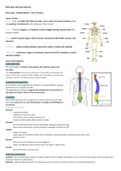Class notes
Pearsons BTEC Sport (D* Revision) - Unit 1 Anatomy and Physiology
- Course
- Institution
- Book
This document covers all the content needed to complete the Pearson's BTEC Unit 1 Anatomy and Physiology Exam. The revision has been produced for a Distinction Star Student this year!
[Show more]




